Not long ago the West felt more populated than it feels now, though census data will tell you that the feeling was an illusion. If you were traveling cross-country by car you'd drive for days over two-lane highways, through villages shaded by a canopy of American elms, down wide streets, past white frame houses, "MODERN CABINS," gas stations with glass-topped pumps, and a main street restaurant: "EAT." Then, out the other side of town and back to the open road until the next town.
The highways followed the railways and the railways followed the river valleys. In rough country the roads often flew above the railroads, nuzzling close to the contours of the higher banks. Coming around a hillside at 20 or 25 miles an hour you'd break into the opening of a canyon with an upward view of the high, blue mesa and down below the hillside falling away to shining rails and white rapids.

Back again on the prairie the land might appear flat but its flatness was full of hidden gulches: "DIP!" In some places dry washes were spaced so closely that a car moving over the apparently flat plain looked like a small boat in a heavy ground swell.
Traveling at night as a child, bundled in blankets in the back of the car, you might see sparks ahead from a train barreling along tracks that paralleled the highway. As you pulled abreast of the locomotive you'd see a warm glow inside the engineer's cab and the fireman, stripped to the waist, shoveling coal into the yellow hell of the boiler's furnace.

Stopping for the night at a "MODERN CABIN… SANITATION APPROVED…" meant half-waking to a mumble of friendly voices allowing as how there was room available, and how far did you folks come today, moving muffled in sleep into a strange-smelling stuccoed room lit by a bare bulb, washing your face in almost-but-not-yet-warm water, and feeling for a final moment rough, clean-smelling sheets.
If you woke before dawn you might hear the quick, fading loneliness of a receding train's far-off whistle before it sank again into the enormous silence. A cock would crow and then, with first light, there would be dew heavy on everything, mist over the prairie, and the earthy, clean smell of adobe and whitewash.
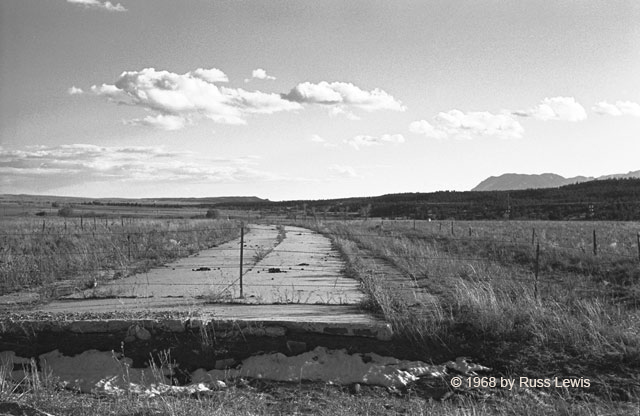
People don’t travel that way any more. Great highways, safe, straight, and sterile shun the rivers and hills and sweep mile after monotonous mile from horizon to horizon. The distance-defining plumes of steam locomotives are gone. The little towns and blue buttes are far off over rolling hills, and the huge green highway signs point to places which, in the understanding of travelers and often in fact, no longer exist.
If you leave the freeway you might find a town where a few wide streets and white houses still bleach in the sun: streets and houses built by people “assured of certain certainties.” But sixty years have robbed these things of context. If you’re lucky you might talk to an elder who remembers the well-kept lawns and what it’s like to creak back and forth in a porch swing on a summer evening. But you have to have done it to understand.
It’s no use trying to turn back the clock. There’s no esthetic justification for preserving two-lane highways, Burma Shave signs, or “Dew Drop Inns.” Neither the artifacts nor the attitudes out of which they grew seem to have much relevance for today. But we ought to remember how much we’re defined by those things. They are behind our eyes and in our bones, and often the shape of things as we see them comes out of that mold.
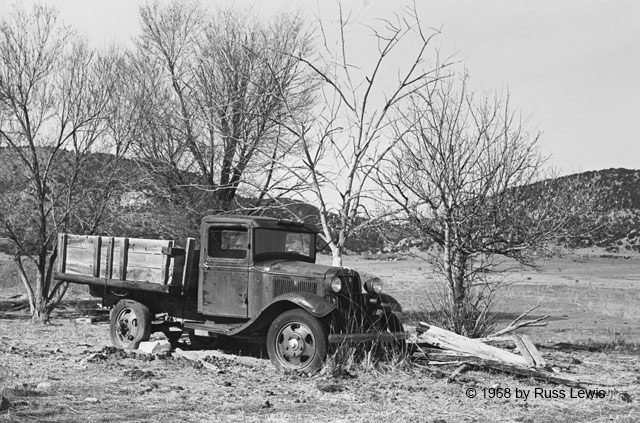
Our American culture grew up on the automobile. It was one of the foundation stones of our prosperity. The family car was a fossil that marked its owner's stratum in our social formations. And eventually our automobile migration over the prairies and mountains jumped the banks of established transportation streams and became a flood that changed the West.
The automobile didn't build Detroit. The towns the automobile built were the little western towns in the middle of nowhere. "LAST CHANCE TO GAS UP…" They were towns that couldn't boast even a fleabag railroad hotel before the cars came; towns whose roots were in agriculture but whose culture soon adjusted to the requirements of the automobile traveler. "FREE AIR..." "ICE COLD POP..." "CABINS..." "EAT..." The flood of automobiles brought to the relative austerity of those rural areas a small but welcome affluence, at least for a few who catered to the trade. The old highways offered a near infinity of routes for any extended trip, and with automobiles that required frequent servicing, travelers dropped in, even at the remotest crossroads.
The automobile invasion of the prairies peaked just before World War II. But even before that a change in agricultural methods began to erode the small towns. Efficient machinery displaced a large part of the fixed population that had supported the small town merchants, and many of the merchants who survived did so by catering to the tourist traffic that resumed after the war. The middle forties saw a frenzied increase in roadside businesses sprouting if not flourishing in rural areas. "ZOO... SEE THE GIANT 20 LB. CANARY..." "HANDMADE BEDSPREADS 600 YARDS…" "GENUINE INDIAN CURIOS AHEAD..."
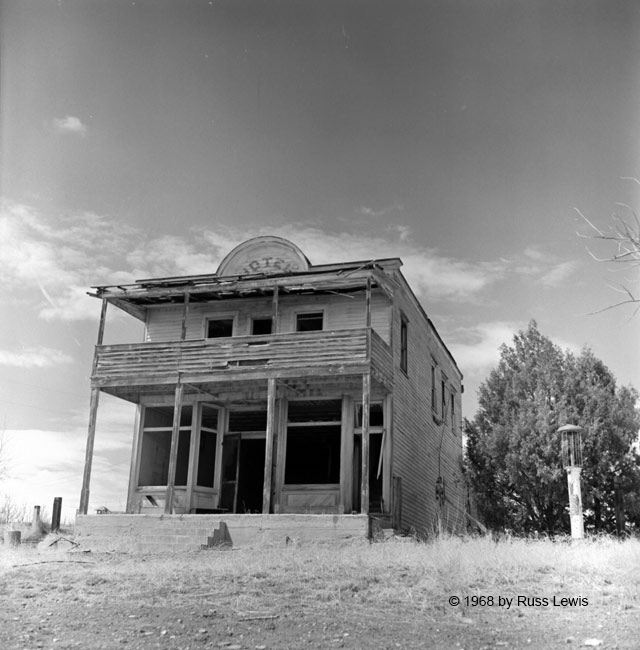
Then the superhighways came – turnpikes and freeways – and the adage, "HARDLY A MAN… IS NOW ALIVE… WHO PASSED ON A HILL… AT SEVENTY FIVE… BURMA SHAVE…" no longer was true.
Superhighways channeled traffic away from the small towns. But more importantly they changed the habits of travelers. Instead of more or less drifting through the countryside, often behind a truck and slowing frequently for unintended sightseeing, "EARLTON VILLAGE LIMIT…" "SPEED LIMIT 25… ENFORCED…" "DON'T KILL A CHILD…" the driver assumed something of the locomotive engineer's mindset. The isolated superhighways meant sightseeing from a distance. The big green signs named towns which, if they existed at all, were in the hinterlands, beyond a hill or two, over roads full of potholes and old raised tarlines. The cross-country driver's objective now was to go as fast as possible, as far as possible at one sitting. Distances between stops were limited only by the capacity of gas tank or bladder and the stops became strictly functional.
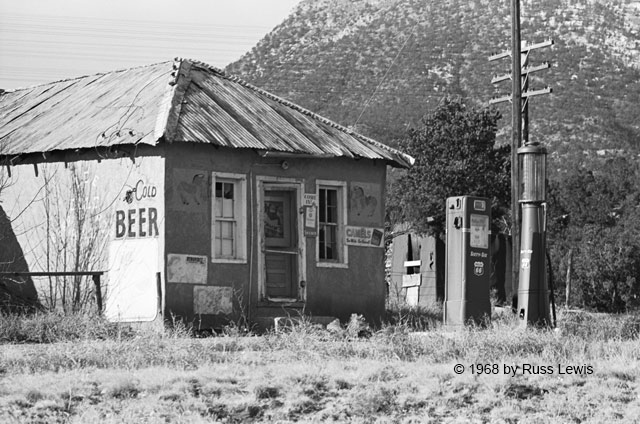
Where it once was reasonable to plan for an average speed of thirty or so miles an hour for a day's drive it became possible to plan for an average of sixty. The merchant had to adapt to the traveler's rising expectations, and no business more than a hundred yards from the superhighway was likely to succeed. "GAS / EAT..." "NEXT EXIT..." "EASY OFF / EASY ON..." In place of a longish pause while the friendly proprietor filled your tank: "Howdy folks. Say, yer a long way from home aintcha?" a trip to the outhouse behind the station, and an "ICE COLD POP…" a highway stop came to resemble a pit stop at the Indianapolis Five Hundred.
Modern highway interchanges often sport a collection of combined gas station / eateries, vying to see who can put up the tallest sign. And behind this row of production-line, traveler-turnaround plants lies the old town as thoroughly bypassed and as surely being swallowed up by weather and time as if it were 200 miles instead of 200 yards from the highway.
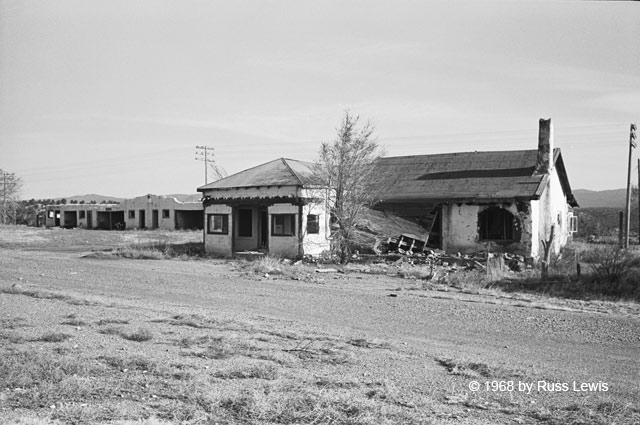
The West has gone through two transportation revolutions in the past ninety years and the second has left it approximately back where it started. Early in the twentieth century the West had a railroad network that clustered most of its population along well-defined paths. Then came the automobile and with it an expansion of family agriculture, spawning a host of small towns that sprang up seemingly at random. Finally, superhighways and mechanized agriculture together are moving the population back along well-defined paths and leaving large areas sparsely populated.
The quality of the West as a succession of small towns is being lost. "PUNKIN CENTER..." "BEAVER CREEK..." "FAWN HOLLOW…" And there's nothing in sight that can keep the earth from swallowing these towns until the West, once again, is a vast, empty prairie, tilled by a few people with a lot of machinery.
Still, enough traces of that first automobile revolution are left to show you something of what it was like if you're willing to leave the superhighway and look. You'd better do it soon though because the buildings and paraphernalia of that time weren't designed to last. They were made by transients for a transient trade, and they're nearly as transient as their proprietors and their customers. Look quickly because in the time it takes to blink your eyes the final remnants of the West's adolescence are going to disappear, forever.